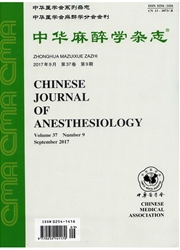

 中文摘要:
中文摘要:
目的评价吸入氢气对脓毒症小鼠急性肺损伤时炎性反应的影响。方法雄性ICR小鼠48只,体重20~25g,5周龄,采用随机数字表法,将其随机分为4组(n=12):假手术组(A组)、假手术+氢气组(B组)、脓毒症组(c组)和脓毒症+氢气组(D组)。采用盲肠结扎穿孔(cLP)法制备脓毒症模型。B组和D组于假手术或CLP后1、6h吸入2%氢气1h。CLP后24h时行行为学评分,随后采集动脉血行血气分析,计算氧合指数;采集静脉血样,随后处死小鼠取肺组织,测定血清及肺组织TNF—α、IL-1β、高迁移率族蛋白B1(HMGB1)和IL-10水平和计算凋亡指数。结果与A组比较,C组和D组行为学评分升高,氧合指数降低,凋亡指数升高,血清及肺组织TNF-α、IL-1β、HMGB1和IL-10水平升高(P〈0.05),B组差异无统计学意义(P〉0.05);与C组比较,D组行为学评分降低,氧合指数升高,凋亡指数降低,血清及肺组织TNF-α、IL-1β和HMGB1水平降低,IL-10水平升高(P〈0.05)。结论吸人氢气可调节促炎和抗炎因子水平平衡,抑制炎性反应,减轻脓毒症小鼠急性肺损伤。
 英文摘要:
英文摘要:
Objective To investigate the effect of inhalation of hydrogen (H2 ) on the inflammation re- sponse during sepsis-induced acute lung injury in mice. Methods Forty-eight male ICR mice, aged 5 weeks, weighing 20-25 g, were randomly divided into 4 groups ( n = 12 each) : sham operation group (group A), sham operation + H2 group (group B), sepsis group (group C) and sepsis + H2 group (group D). Sepsis was pro- duced by cecal ligation and puncture (CLP) . Groups B and D received 1 h inhalation of 2% H2 at 1 and 6 h after CLP or sham operation. The behavior was assessed and scored at 24 h after CLP. Arterial blood samples were tak- en for blood gas analysis. Oxygenation index was calculated. Venous blood samples were taken for determination of the levels of serum tumor necrosis factor-α (TNF-α), interleukin-I (IL-1β), high mobility group protein B1 (HMGB1) and interleukin-10 (IL-10). The mice were then sacrificed and lungs were removed for determination of the levels of TNF-a, IL-1β, HMGB1 and IL-10 in lung tissues. The apoptotic index was calculated. Results Compared with group A, the behavior score, apoptotic index and levels of TNF-a, IL-1β, HMGB1 and IL-10 were increased, and the oxygenation index was decreased in groups C and D, and no significant change was found in the parameters mentioned above in group B. Compare with group C, the oxygenation index and level of IL-10 were sig- nificantly increased, and the behavior score, apoptotic index and levels of TNF-α, IL-1β and HMGBI were signifi- cantly decreased in group D. Conclusion Inhalation of H2 can regulate the balance between pro- and anti-inflam- matory eytokines, inhibit the inflammation response and alleviate sepsis-induced acute lung injury in mice.
 同期刊论文项目
同期刊论文项目
 同项目期刊论文
同项目期刊论文
 Heme oxygenase-1 mediates the anti-inflammatory effect of molecular hydrogen in LPS-stimulated RAW 2
Heme oxygenase-1 mediates the anti-inflammatory effect of molecular hydrogen in LPS-stimulated RAW 2 Protective effects of hydrogen-rich saline in a rat model of permanent focal cerebral ischemia via r
Protective effects of hydrogen-rich saline in a rat model of permanent focal cerebral ischemia via r Inhalation of hydrogen gas attenuates brain injury in mice with cecal ligation and puncture via inhi
Inhalation of hydrogen gas attenuates brain injury in mice with cecal ligation and puncture via inhi Beneficial effects of hydrogen-rich saline against spinal cord ischemia-reperfusion injury in rabbit
Beneficial effects of hydrogen-rich saline against spinal cord ischemia-reperfusion injury in rabbit 期刊信息
期刊信息
